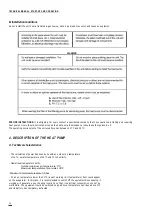
TECHNICAL MANUAL. START-UP AND OPERATION
With the aim of reducing the amount of electrical and electronic equipment residues and the
danger of their components, to promote the recycling of the equipment and the appreciation of
their residues, and to determine a suitable management that attempts to improve the
effectiveness of the environmental pro-tection, a series of regulations applicable to the
manufacturing of the product and others related to the correct environmental management when
they become residues have been implemented.
It is also envisaged to improve the environmental behaviour of all the agents involved in the
service life of the electrical and electronic equipment, such as the producers, distributors, users
and, specially, those agents directly involved in the management of the residues derived from this
equipment.
As of 13 August 2005, when you wish to throw away this unit, you have two possible return systems:
- if you acquire a new one that is of an equivalent type or it has the same functions as the one thrown away, you could
hand it over
at no cost to the distributor.
- or you could take it to the place so selected by the local authorities.
We shall cover waste treatment costs.
The apparatus are labelled with a symbol of a “crossed-out waste container”. This symbol means that the apparatus is
subject to selected waste collection, different from general waste collection.
Our products are designed and manufactured with top-quality, environmental-friendly materials and components, which
can be reused and recycled. In spite of this, several parts of this product are not biodegradable and therefore it should not
be left in the environment.
PVC
The most used plastifying agent in the different PVC applications is the DEHP (di-2-ethyl hexyl phthalate). The tests
conducted in different laboratories demonstrate that it does not present risks for human health in the concentration levels
so used in finished arti-cles, according to the information from the German BUA (Advisory Body for the Relevant
Environment of the Existing Substances) and the VGA (German Health Authority) among others. The results of these tests,
together with the data collected in biodegrada-tion studies, confirm that the DEHP cannot be considered dangerous for the
environment. All additives used in the PVC formula-tions and therefore in the food industry applications are perfectly
regulated at both European and Spanish level.
In Europe, the EC Directive 90/128/EU, later modified by the 95/3/EU. In Spain, we should mention the Royal Decrees
1125/1982 of 30 April 1982, later confirmed by the 1042/1997 of 27 June 1982.
Modern technology applied for years in the PVC production plants allow us to state that they do not mean a danger for the
environment. The service life analyses (SLA) demonstrate that the environmental impact of the PVC is equivalent or even
more favourable than those corresponding to other materials.
TITANIUM
Health effects. Elemental titanium and titanium dioxide are of a low order of toxicity. Humans overexposed
to titanium dioxide via inhalation can develop slight changes in lungs.
Effects of overexposure to titanium powder. Dust inhalation may cause tightness and pain in chest, coughing, and
difficulty in bre-athing. Contact with skin or eyes may cause irritation. Routes of entry: Inhalation, skin contact, eye
contact.
Carcinogenicity. The International Agency for Research on Cancer (IARC) has listed titanium dioxide within Group 3 (The
agent is not classifiable as to its carcinogenicity to humans.)
Eespeciallytal effects. Low toxicity. No negative environmental effects of titanium have been reported.
42
Содержание 55234
Страница 2: ......
Страница 11: ...11 ATTENTION POMPE Á CHALEUR PacECO français ...
Страница 29: ...ATTENTION PacECO HEAT PUMP english 29 ...
Страница 47: ...ATENCIÓN BOMBA DE CALOR PacECO español 47 ...
Страница 65: ...deutsch ACHTUNG 65 ...
Страница 83: ...ATTENZIONE POMPA DI CALORE PacECO italiano 83 ...
Страница 101: ...OPGELET PacECO WARMTEPOMP nederlands 101 ...
Страница 119: ...ATENÇÁO BOMBA DE CALOR PacECO portugués 119 ...
















































